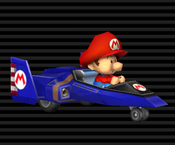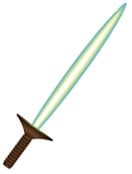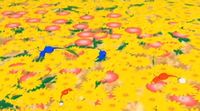List of references in the Mario series
This article is under construction. Therefore, please excuse its informal appearance while it is being worked on. We hope to have it completed as soon as possible.
The following is a list of references to other media that has appeared in the Mario series. Note that references to other Mario series games are not included here nor are references made in crossover games.
References
Mario Bros.
- The music that plays when the player begins Phase 1 is Mozart's Eine kleine Nachtmusik.
All Night Nippon Super Mario Bros.
- This game was an officially licensed hack of Super Mario Bros.. It referenced the Japanese radio program All Night Nippon by replacing certain enemies and objects with Japanese celebrities.
Super Mario series
Super Mario Bros. 3
- The tune the Warp Whistle plays is also found in The Legend of Zelda. The whirlwind is from the same game. The tune is later found in The Legend of Zelda: The Minish Cap, although a bird sweeps Link away, not a whirlwind. It is also played on an ocarina, not a flute. The notes are also a part of the title theme of The Legend of Zelda: Ocarina of Time.
Super Mario Sunshine
- If the game is hacked to remove Il Piantissimo's mask, he has the same face of the Running Man / Postman of Termina, from The Legend of Zelda: Ocarina of Time and The Legend of Zelda: Majora's Mask only with darker skin.
Super Mario Galaxy
- Octopi resemble and behave in the same way as Deku Scrubs and Octoroks from The Legend of Zelda.
- In the Rolling Gizmo Galaxy, a hidden bunch of Star Bits formed in a Rupee shape can be seen.
- Star bits from this game are based off candy. The candy is called Konpeito & is quite popular in Japan.
- The battle against Megaleg is based off the Giant Ganon boss planned for The Legend of Zelda: Ocarina of Time
Super Mario 3D Land
- In World 5-2, when Mario/Luigi opens the area that contains the second Star Medal, the Zelda "found a secret" theme is heard.
Super Mario Bros. & Friends: When I Grow Up
- Link makes a cameo in the chef/waiter page and on the travel guide page.
Super Mario Land 2: 6 Golden Coins
- Level 4 of the Mario Zone features LEGO-like surfaces. At one point in the level, it is revealed that these are not actually LEGOs, but N&B Blocks, a toy manufactured by Nintendo in the 1960's.
- Level 2 of the Turtle Zone has Unibōs, enemies that strongly resemble Gordos from the Kirby series.
Wario Land series
Wario Land: Super Mario Land 3
- Several sound effects of this game are borrowed from Metroid II: Return of Samus, such as the pause sound effect and the sound that plays when Wario hits a boss.
Wario Land II
- When the player has completed the game a remake of the 1980 Game & Watch game Flagman appears, called Flagman DD.
- Some of the treasures in this game come from The Legend of Zelda series, such as the Flute, a purple Rupee, the Power Glove, and the Pegasus Boots. A Crystal Metroid also appears as a reference to the Metroid series.
Donkey Kong Country series
Donkey Kong Country
- This game introduced Diddy Kong, who has always appeared with his cap with the Nintendo logo on it.
- Dixie Kongs hat also had the Rare Ltd. logo on her hat. This stayed with her until Rare was purchased by Microsoft.
- In the Game Boy Advance version of Donkey Kong Country, Sabrewulf is stuffed and mounted in Cranky's hut, but it is still alive as it occasionally blinks.
- Early releases of the game featured the logo of Dole Fruits on the giant bananas.
Donkey Kong Country 2: Diddy Kong's Quest
- After the player has beaten the game, they can take part in Cranky's Video Game Heroes competition. The competition is simply whichever video game hero can collect the most coins. When the player first sees this competition the heroes already present are Mario, Yoshi and Link. A garbage can can also be seen at the competition with Sonic's shoes and Earthworm Jim's raygun, implying they failed to get enough coins in the competition.
- Chief Thunder, a character from the fighting game Killer Instinct, makes his cameo on a poster in Cranky's Cabin.
Donkey Kong Country 3: Dixie Kong's Double Trouble!
- Bazaar mentions Link in his Bazaar's General Store.
- When visiting Wrinkly's Save Cave sometimes she'll be playing her Nintendo 64 and the game she's playing is Super Mario 64. At the time, a remix of the Princess Peach's Castle theme is heard. It can also be accessed from the Music Test menu from cheats after highlighting a game file and doing the button code: "
,
,
,
,
,
,
,
,
,
".
Donkey Kong Country Returns 3D
- In Cranky Kong's Shop, if the player keeps the Portable DK Barrel selected for a while, Cranky makes a reference to The Legend of Zelda saying "It's dangerous to go alone. Buy this!", while "It's dangerous to go alone. Take this!" is the original sentence.
Hotel Mario
- All of the hotels owned by the Koopalings are puns on famous Real World hotels.
- Some of Mario's lines reference popular culture such as "We ain't afraid of no Koopas!" (a play on the line "I ain't afraid of no ghost!" from the Ghostbusters theme song) and "Hey, you! Get off-a my cloud!" from the Rolling Stones song, "Get Off of My Cloud."
Super Mario RPG: Legend of the Seven Stars
- Link can be found sleeping in the Rose Town inn after beating Bowyer in the Forest Maze.
- Samus can be found sleeping in the guest bed of Toadstool's Castle after beating Yaridovich, and before going to Land's End. When spoken to, she'll say she's resting up for Mother Brain, the end boss of the Metroid series.
- A Samus action figure can be found in a toy box in Booster Tower.
- Hinopio in the Barrel Volcano has models of Captain Falcon's and Samurai Goro's spacecraft, and an Arwing from the Star Fox series.
- Several references to the Final Fantasy series, are in this game, due to the game being produced by Squaresoft.
- Culex is an optional boss designed to resemble the Final Fantasy bosses. During and after the battle with him, Final Fantasy music is played. The music heard is a remix of the Boss Battle theme in Final Fantasy IV and after the battle, the famous Final Fantasy Victory Theme played. His Elemental Crystals are also the same as in Final Fantasy IV.
- The enemy Bahamutt is named after the powerful dragon Bahamut from the Final Fantasy series.
- The Czar Dragon shares its name with a superboss that does not appear in but exists within the coding for Final Fantasy VI.
- Upon encountering Bowyer, Mario attempts to simply charge toward Bowyer, fist punching, but Mallow holds him back and exclaims, "Who do think you ARE??? Bruce Lee!?"
Super Mario World 2: Yoshi's Island
- In the German version of this game, 'Naval Piranha' is called 'Audrey', referencing "The Little Shop of Horrors".
Yoshi's Story
- In Stages 2-3 and 2-4, the name "Zelda" appears in the newspaper in the background.
Diddy Kong Racing
Diddy Kong Racing DS
- Dixie Kong's hat shows a silver Rareware logo on it but only when an event happens while racing that she is shown through a box.
Super Smash Bros. Series
Super Smash Bros.
- The Beam Sword from this game series bears a strong resembelance to the Lightsabers of the Star Wars franchise.
Mario Golf series
Mario Golf
- In Mario Golf for the Nintendo 64, the names of various The Legend of Zelda and Star Fox characters appear on the scoreboard.
Mario Golf
- In Mario Golf for the Game Boy Color, the last club is called "Link's Club" and uses the Triforce as its logo.
Mario Golf: Toadstool Tour
- If the golf ball is hit and lands on a patch of flowers, several Pikmin will pop out from the ground.
- The Coin Attack mode can spawn coins in the shape of the Triforce.
Donkey Kong 64
- Two classic arcade games Jetpac and Donkey Kong were included as bonus features in this game.
- In the final Boss fight of this game, Nintendo and Rareware are announced as the sponsors.
- In the Beta version of this game Banjo and Kazooie made cameos as fridge magnets.
Mario Party series
Many of the minigames that appear in the Mario Party series have names that are puns or references to popular culture.
Mario Party 2
- Many of the minigames are puns on pop culture, such as Dizzy Dancing and Magnet Carta.
- Western Land is named after an area in Tokyo Disneyland.
Mario Party 3
This game continues to have minigame titles make puns on popular culture, including:
Mario Party 4
More minigames are puns, they are:
Mario Party 5
Minigames that make puns in this game are
- Mazed and Confused
- Flower Shower
- Night Light Fright
- Coney Island
- Merry Poppings
- Bound of Music
- Rain of Fire
Mario Party 6
Minigames that make puns in this game are:
Mario Party 7
Minigames that make puns in this game are:
Mario Party Advance
- The non-playable character Shroomlock is an obvious reference to the fictional detective, Sherlock Holmes. He claims to be from Toadland Yard, a reference to Scotland Yard.
Paper Mario series
Paper Mario
- The Koopa Bros. are based upon the Teenage Mutant Ninja Turtles
- The game's end credits sequence is an obvious parody of Disney's Main Street Electrical Parade
Paper Mario: The Thousand-Year Door
- In Petalburg a young Toad says he's been playing Fire Emblem.
- Petalburg shares the name of a city in the Pokémon series.
- In one of the trivia games, one of the choices for how to defeat the demon is a "legendary sword". This is a reference to the Master Sword from the The Legend of Zelda series.
Super Paper Mario
- In Chapter 2-3, for knocking over a vase, Mario must pay his debt in Rubees, a reference to Rupees, the currency for the The Legend of Zelda series. (Additionally, Rubees resemble red Rupees); Mimi also attacks using this currency in Chapter 6-2. Rupees were also called Rubees in the non-canon The Legend of Zelda games for the Philips CD-i system.
- One of the Dorguys has puzzles for the character to solve that are similar to those of the Brain Age series. When solving them, he also states that the players' "brain ages must be very young".
- The Underwhere and many of its aspects and inhabitants (i.e. Underchomp to Cerberus and River Twygz to River Styx) refer to the Greek underworld mythology.
- The way in which the Underchomp is fought is heavily inspired by Nintendo Entertainment System RPGs, such as MOTHER and Dragon Warrior.
Paper Mario: Sticker Star
- The business of Shady Toad and Sling-a-Thing Toad is implied to be illegal and secret, referencing the real-life black markets.
- The Squirt Gun thing is clearly based on first-person shooter video-games when used in-battle.
Luigi's Mansion
- The boxart of this game resembles the cover design of Home Alone.
- If Luigi goes to the door to King Boo's alter before capturing the required amount of boos, a scene will show King Boo mistaking Luigi for Mario. In the scene, King Boo states that, "I will not give up my favorite decoration, I like Mario just where he is". This is a reference to the film Star Wars Episode VI: Return of the Jedi, in which Jabba the Hutt states, "I will not give up my favorite decoration, I like Captain [Han] Solo just where he is". Han Solo hangs frozen in carbonite on a wall similar to Mario being trapped in King Boo's painting.
Luigi's Mansion: Dark Moon
- The scene where Luigi inspects his TV in the game's introduction is a reference to a scene from the movie Poltergeist.
- The scene inside the Hollow Tree in Haunted Towers where Luigi looks down the staircase is a reference to both the movie Vertigo and the famous camera effect introduced on it, dolly zoom.
- The scene in Treacherous Mansion where two Strong Greenies bring a suit of armor to life references to the Frankenstein movies.
Game & Watch Gallery 4
- This game includes The Legend of Zelda Game & Watch port.
WarioWare series
WarioWare, Inc.: Mega Microgame$!
- 9-Volt's stage microgames all refer to Nintendo's hardware or software. They are listed here.
- Many names for microgames are references. Examples: Ring My Bell, Unexcite Bike, etc.
- The Maze That Pays is a possible parody of Pac-Man.
WarioWare: Twisted!
- 9-Volt and 18-Volt's stage continues to feature classic Nintendo games. A list of these is found here.
- Some microgames' names are, again, puns. Examples: Twist and Sprout, Soda Jerk, etc.
- Open-And-Shut Case microgame makes a reference to Little Red Riding Hood.
- Slap Jack! microgame is inspired by the fairy tale Jack and the Beanstalk in the North American version, and by Journey to the West in Japan.
WarioWare: Touched!
- 9-Volt and 18-Volt's microgames once again involve Nintendo products. A list of their microgames is found here.
- More microgames have pun names. Examples: The Proud, the Fuse, Abdominal Blowman, etc.
WarioWare: Smooth Moves
- 9-Volt and 18-Volt's features Nintendo references, but unlike the previous games, there are more recent games involved. A list of their microgames is found here.
- Many microgames use references for their names. Examples: BYOM, Sure, You Can, etc.
- The background of Universal Marionette is a spoof of Leonardo da Vinci's drawing, the Vitruvian Man.
- When the first level of the microgame, Clock-Watcher is won, a rabbit appears and runs through the screen, a reference to Alice's Adventures in Wonderland.
Wario World
- Several Nintendo consoles appear as treasures, they are the NES, the Game Boy Advance, the Nintendo 64 and the Nintendo GameCube.
Mario & Luigi: Superstar Saga
- Kirby and Stafy cameo on posters at the Yoshi Theater.
- Starbeans Café is a pun on Starbucks Café.
- Wario, Fox McCloud, Captain Olimar, Samus, an Excitebiker and Link were all going to make appearances at the café, but they were all replaced by a single appearance by Professor E. Gadd. However several of the items he gives to the Mario Bros. appear to be similar to the ones it was revealed these characters were going to give out.
Donkey Konga series
Donkey Konga
The Donkey Konga series includes both famous songs and music from other Nintendo franchises. The songs are different in each reigion. All of these songs are listed here.
Donkey Konga 2
More songs from both popular culture and other Nintendo games.
Mario Kart series
Mario Kart DS
- R.O.B. is the final unlockable character. This is first introduced non-Mario character in Mario Kart series.
- R.O.B.s standard symbol is the D-pad from the Nintendo Entertainment System.
Mario Kart Wii

- The kart Blue Falcon is a reference to the vehicle of the same name in the F-Zero series, driven by Captain Falcon. The two vehicles also appear physically similar. Also, Rainbow road features many items and a launch star from Super Mario Galaxy.


